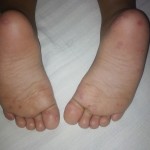 My sweet little niece was sick recently with irritability, poor appetite, fever, and an impressive rash. It turned out she had Hand-Foot-and-Mouth (HFM) disease. Needless to say, my sister had a few questions for her ‘Infectious Diseases’ sister…of course. Following are 10 questions, with answers, about this infectious disease.
My sweet little niece was sick recently with irritability, poor appetite, fever, and an impressive rash. It turned out she had Hand-Foot-and-Mouth (HFM) disease. Needless to say, my sister had a few questions for her ‘Infectious Diseases’ sister…of course. Following are 10 questions, with answers, about this infectious disease.
1 – What causes HFM disease? Hand-Foot-and-Mouth is a long name for a disease, isn’t it? A real mouthful! Anyway, this disease is caused by an Enterovirus. There are many types but the main culprit is a Coxsackie A virus. The virus is quite contagious and is spread mainly by what we call the ‘fecal-oral’ route, meaning that the virus is shed in the stool. Surfaces contaminated with stool are touched, then the contaminated hands are put in the mouth and infection occurs. That is why this infection is more common in children in daycare centers, because of their lack of potty training. The virus is also be present in respiratory secretions and so coughing, sneezing, etc. can result in spread of the virus.
2 – When is HFM disease most likely to occur? Infection with Coxsackie virus is most common during the late summer and early fall. Infection occurs mainly in children less than 10 years old, although adults infections do happen (especially young adults). Spread is usually in daycare centers and schools. Adults changing the diapers of infected infants can be affected.
3 – What are the symptoms and signs of HFM disease? Illness usually develops 3 to 5 days after exposure. Classic features include irritability, fever as high as 102’F, sore throat or sore mouth, and rash. The rash may be a combination of bumps and blisters (with red borders) on the hands, feet, and sometimes in the diaper region, especially on the buttocks. At the same time, bumps and/or blisters are present in the mouth, particularly on the inner cheeks and sides of the tongue. The fever usually lasts 1-2 days however the rash persists for 7-10 days.
4 – How long is HFM disease contagious for? HFM disease is most contagious during the first week of the illness when fever and rash are present. However, it is possible for infection to be spread beyond that time, since the virus may persist in stool for over 8 weeks from initial infection.
5 – Can you get HFM disease more than once? Yes, someone can get HFM disease more than once, since several strains of Coxsackie A virus, and other Enteroviruses, can cause the infection. Antibodies which form after infection with one strain of virus, do not protect against infection with another strain of virus.
6 – What are some of the risks for getting HFM disease? Having young children in the household, and attending, or being employed in a daycare center, are the most relevant risk factors for infection with Coxsackie virus.
7 – What’s the best way to treat HFM disease? Management of this disease involves treating the symptoms as there is no specific antiviral drug. Fever and pain may be treated with acetaminophen or ibuprofen, and itching with antihistamines and/or calamine lotion. Though the appetite is poor initially, children should be encouraged to at least drink fluids to maintain good hydration, especially when fever is present. Cold liquids may be more tolerable. Spicy or acidic substances may cause discomfort.
8 – How can HFM disease be prevented? There is no vaccine against Coxsackie viruses. Prevention involves reduction of person-to-person contact where practicable, that is, avoid crowds. Affected children should be kept at home until the fever and rash resolve, which may be for up to 10 days. Because the virus may be shed in the stool for weeks after infection, hand washing is paramount. Persons working in daycare centers should wash their hands promptly after changing a child’s stool soiled diaper/clothing, to prevent spread to other children.
9 – Are there any complications of HFM disease? Complications of this disease are rare. HFM disease caused by other Enterovirus strains may rarely be associated with meningitis (inflammation of the covering of the brain), paralysis, and other neurologic symptoms. Death is rare with HFM disease. The vast majority of patients with HFM disease recover fully.
10- Can adults get HFM disease? Most infections in adults are asymptomatic or very mild with malaise and low grade fever, usually no rash. Of note, adults without symptoms can still spread the virus to others, which is why hand washing remains of utmost importance, in general. There have been rare case reports of miscarriages associated with HFM disease.
Leave a Reply